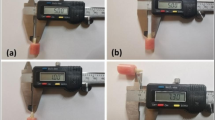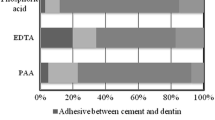Abstract
Objectives
To evaluate the bond strength of four types of posts (pre-fabricated fiberglass post, fiberglass post anatomized with composite resin, milled fiberglass post, and milled polyetheretherketone (PEEK) post), and two types of resin cements (conventional and self-adhesive) by assessing immediate bond strength and post-mechanical aging at each root third.
Materials and methods
Bovine endodontically treated roots (16 groups, n = 8) were prepared and the posts were produced and luted; the specimens of aging groups were cycled (300,000 cycles under 50 N load at 1.2 Hz frequency); six slices of each root were obtained; push-out test was performed by using a universal testing machine (500 N load at 1 mm/min cross speed); fracture pattern was classified into five levels. The statistical analyses used were three-way ANOVA, Tukey’s test (for bond strength), and Fisher’s test (for fracture pattern) (α < 0.05).
Results
Differences were found between the cements for posts (conventional: p < 0.001; self-adhesive: p = 0.002), whereas no difference was found for root region (p = 0.941; p = 0.056, respectively); analysis of each root showed significant differences for cements (p < 0.001), posts (p < 0.001), and mechanical cycling (p = 0.001); in terms of double interaction, differences were found for posts and mechanical cycling (p = 0.005); no other interactions were observed (double or triple); the fracture pattern showed difference between the groups for both cements.
Conclusions
Milled PEEK posts seem to be a good clinical option, but they require improvement of CAD-CAM technology and advances towards their adhesion.
Clinical relevance
Milled posts are promising and can reduce clinical time for rehabilitation of extensively destroyed teeth.




Similar content being viewed by others
References
Ruschel GH, Gomes ÉA, Silva-Sousa YT, Pinelli RGP, Sousa-Neto MD, Pereira GKR, Spazzin AO (2018) Mechanical properties and superficial characterization of a milled CAD-CAM glass fiber post. J Mech Behav Biomed Mater 82:187–192. https://doi.org/10.1016/j.jmbbm.2018.03.035
Assif D, Gorfil C (1994) Biomechanical considerations in restoring endodontically treated teeth. J Prosthet Dent 71(6):565–567. https://doi.org/10.1016/0022-3913(94)90438-3
Leme AA, Coutinho M, Insaurralde AF, Scaffa PM, da Silva LM (2011) The influence of time and cement type on push-out bond strength of fiber posts to root dentin. Oper Dent 36(6):643–648. https://doi.org/10.2341/10-404-L
Cadenaro M, Maravic T, Comba A, Mazzoni A, Fanfoni L, Hilton T, Ferracane J, Breschi L (2019) The role of polymerization in adhesive dentistry. Dent Mater 35(1):e1–e22. https://doi.org/10.1016/j.dental.2018.11.012
Parčina Amižić I, Baraba A, Ionescu AC, Brambilla E, Van Ende A, Miletić I (2019) Bond Strength of Individually Formed and Prefabricated Fiber-reinforced Composite Posts. J Adhes Dent 21(6):557–565. https://doi.org/10.3290/j.jad.a43649
Taneja S, Kumar P, Gupta N, Khan R (2019) Influence of type of cement and their thickness on stress distribution at dentin-cement interface of computer-aided designed glass fiber post: A three-dimensional finite element analysis. J Conserv Dent 22(3):228–232. https://doi.org/10.4103/JCD.JCD_457_18
Grandini S, Sapio S, Simonetti M (2003) Use of anatomic post and core for reconstructing an endodontically treated tooth: a case report. J Adhes Dent 5(3):243–7
Eid R, Azzam K, Skienhe H, Ounsi H, Ferrari M, Salameh Z (2019) Influence of Adaptation and Adhesion on the Retention of Computer-aided Design/Computer-aided Manufacturing Glass Fiber Posts to Root Canal. J Contemp Dent Pract 20(9):1003–1008
Skirbutis G, Dzingutė A, Masiliūnaitė V, Šulcaitė G, Žilinskas J (2017) A review of PEEK polymer’s properties and its use in prosthodontics. Stomatologija 19(1):19–23
Teixeira KN, Duque TM, Maia HP, Gonçalves T (2020) Fracture Resistance and Failure Mode of Custom-made Post-and-cores of Polyetheretherketone and Nano-ceramic Composite. Oper Dent 45(5):506–515. https://doi.org/10.2341/19-080-L
Stawarczyk B, Thrun H, Eichberger M, Roos M, Edelhoff D, Schweiger J, Schmidlin PR (2015) Effect of different surface pretreatments and adhesives on the load-bearing capacity of veneered 3-unit PEEK FDPs. J Prosthet Dent 114(5):666–673. https://doi.org/10.1016/j.prosdent.2015.06.006
Ibrahim RO, Al-Zahawi AR, Sabri LA (2020) Mechanical and thermal stress evaluation of PEEK prefabricated post with different head design in endodontically treated tooth: 3D-finite element analysis. Dent Mater J. https://doi.org/10.4012/dmj.2020-053
Stawarczyk B, Jordan P, Schmidlin PR, Roos M, Eichberger M, Gernet W, Keul C (2014) PEEK surface treatment effects on tensile bond strength to veneering resins. J Prosthet Dent 112(5):1278–1288. https://doi.org/10.1016/j.prosdent.2014.05.014
Schmidlin PR, Stawarczyk B, Wieland M, Attin T, Hämmerle CH, Fischer J (2010) Effect of different surface pre-treatments and luting materials on shear bond strength to PEEK. Dent Mater 26(6):553–559. https://doi.org/10.1016/j.dental.2010.02.003
Silva NRD, Rodrigues MP, Bicalho AA, Soares PBF, Price RB, Soares CJ (2019) Effect of Resin Cement Mixing and Insertion Method into the Root Canal on Cement Porosity and Fiberglass Post Bond Strength. J Adhes Dent 21(1):37–46. https://doi.org/10.3290/j.jad.a41871
Tagger M, Tamse A, Katz A, Korzen BH (1984) Evaluation of the apical seal produced by a hybrid root canal filling method, combining lateral condensation and thermatic compaction. J Endod 10(7):299–303. https://doi.org/10.1016/S0099-2399(84)80183-1
Lima JF, Lima AF, Humel MM, Paulillo LA, Marchi GM, Ferraz CC (2015) Influence of irrigation protocols on the bond strength of fiber posts cemented with a self-adhesive luting agent 24 hours after endodontic treatment. Gen Dent 63(4):22–26
Freitas TL, Vitti RP, Miranda ME, Brandt WC (2019) Effect of Glass Fiber Post Adaptation on Push-Out Bond Strength to Root Dentin. Braz Dent J 30(4):350–355. https://doi.org/10.1590/0103-6440201902491
Macedo VC, Souza NA, Faria e Silva AL, Cotes C, da Silva C, Martinelli M, Kimpara ET (2013) Pullout bond strength of fiber posts luted to different depths and submitted to artificial aging. Oper Dent 38(4):E1-6
Silva GR, Santos-Filho PC, Simamoto-Júnior PC, Martins LR, Mota AS, Soares CJ (2011) Effect of post type and restorative techniques on the strain and fracture resistance of flared incisor roots. Braz Dent J 22(3):230–237. https://doi.org/10.1590/s0103-64402011000300009
Silva RA, Coutinho M, Cardozo PI, Silva LA, Zorzatto JR (2011) Conventional dual-cure versus self-adhesive resin cements in dentin bond integrity. J Appl Oral Sci 19(4):355–362. https://doi.org/10.1590/s1678-77572011005000010
Skupien JA, Sarkis-Onofre R, Cenci MS, Moraes RR, Pereira-Cenci T (2015) A systematic review of factors associated with the retention of glass fiber posts. Braz Oral Res 29:S1806-83242015000100400. https://doi.org/10.1590/1807-3107BOR-2015.vol29.0074
Lung CY, Matinlinna JP (2012) Aspects of silane coupling agents and surface conditioning in dentistry: an overview. Dent Mater 28(5):467–477. https://doi.org/10.1016/j.dental.2012.02.009
Manso AP, Carvalho RM (2017) Dental Cements for Luting and Bonding Restorations: Self-Adhesive Resin Cements. Dent Clin North Am 61(4):821–834. https://doi.org/10.1016/j.cden.2017.06.006
Mergulhão VA, de Mendonça LS, de Albuquerque MS, Braz R (2019) Fracture Resistance of Endodontically Treated Maxillary Premolars Restored with Different Methods. Oper Dent 44(1):E1–E11. https://doi.org/10.2341/17-262-L
Soejima H, Takemoto S, Hattori M, Yoshinari M, Kawada E, Oda Y (2013) Effect of adhesive system on retention in posts comprising fiber post and core resin. Dent Mater J 32(4):659–666. https://doi.org/10.4012/dmj.2013-078
Zicari F, De Munck J, Scotti R, Naert I, Van Meerbeek B (2012) Factors affecting the cement-post interface. Dent Mater 28(3):287–297. https://doi.org/10.1016/j.dental.2011.11.003
Başaran G, Göncü Başaran E, Ayna E, Değer Y, Ayna B, Tuncer MC (2019) Microtensile bond strength of root canal dentin treated with adhesive and fiber-reinforced post systems. Braz Oral Res 33:e027. https://doi.org/10.1590/1807-3107bor-2019.vol33.0027
Goracci C, Fabianelli A, Sadek FT, Papacchini F, Tay FR, Ferrari M (2005) The contribution of friction to the dislocation resistance of bonded fiber posts. J Endod 31(8):608–612. https://doi.org/10.1097/01.don.0000153841.23594.91
Funding
This research was supported by The Brazilian National Council for Scientific and Technological Development (CNPq) under grant number 310089/2016–6.
Author information
Authors and Affiliations
Corresponding author
Ethics declarations
Ethics approval
Not necessary for this kind of research.
Informed consent
Not necessary for this kind of research.
Competing interests
The authors declare no competing interests.
Additional information
Publisher's note
Springer Nature remains neutral with regard to jurisdictional claims in published maps and institutional affiliations.
Rights and permissions
Springer Nature or its licensor holds exclusive rights to this article under a publishing agreement with the author(s) or other rightsholder(s); author self-archiving of the accepted manuscript version of this article is solely governed by the terms of such publishing agreement and applicable law.
About this article
Cite this article
Monteiro, L.C., Pecorari, V.G.A., Gontijo, I.G. et al. PEEK and fiberglass intra-radicular posts: influence of resin cement and mechanical cycling on push-out bond strength. Clin Oral Invest 26, 6907–6916 (2022). https://doi.org/10.1007/s00784-022-04645-0
Received:
Accepted:
Published:
Issue Date:
DOI: https://doi.org/10.1007/s00784-022-04645-0




